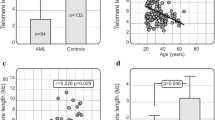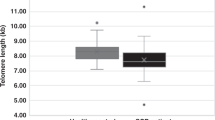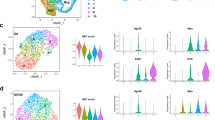Abstract
Excessive telomere shortening has been demonstrated in inherited and acquired blood disorders, including aplastic anemia and myelodysplastic syndromes. It is possible that replicative exhaustion, owing to critical telomere shortening in hematopoietic progenitor cells (HPCs), contributes to the development of cytopenias in these disorders. However to date, a direct link between the telomere length (TL) of human HPCs and their proliferative potential has not been demonstrated. In the present investigation, the TL and level of telomerase enzyme activity (TA) detected in cord blood (CB)-derived HPCs was found to predict erythroid expansion (P<0.01 and P=0.01 respectively). These results were corroborated by a correlation between proliferation of erythroid cells and telomere loss (P=0.01). In contrast, no correlations were found between initial TL, telomere loss or TA and the expansion of other myeloid lineage-committed cells. There was also no correlation between TL or TA and the number of clonogenic progenitors, including primitive progenitors derived from long-term culture. Our investigations revealed upregulation of telomerase to tumor cell levels in CD34− cells undergoing erythroid differentiation. Together, these results provide new insight into the regulation of TL and TA during myeloid cell expansion and demonstrate that TL is an important determinant of CB-derived erythroid cell proliferation.
This is a preview of subscription content, access via your institution
Access options
Subscribe to this journal
Receive 12 print issues and online access
$259.00 per year
only $21.58 per issue
Buy this article
- Purchase on Springer Link
- Instant access to full article PDF
Prices may be subject to local taxes which are calculated during checkout




Similar content being viewed by others
References
Yamada O, Oshimi K, Motoji T, Mizoguchi H . Telomeric DNA in normal and leukemic blood cells. J Clin Invest 1995; 95: 1117–1123.
Leteurtre F, Li X, Guardiola P, Le Roux G, Sergere J-C, Richard P et al. Accelerated telomere shortening and telomerase activation in Fanconi's anemia. Br J Haematol 1999; 105: 883–893.
Ball SE, Gibson FM, Rizzo S, Tooze JA, Marsh JCW, Gordon-Smith EC . Progressive telomere shortening in aplastic anemia. Blood 1998; 91: 3582–3592.
Ohyashiki JH, Ohyashiki K, Fujimura T, Kawakubo K, Shimamoto T, Iwabuchi A et al. Telomere shortening associated with disease evolution patterns in myelodysplastic syndromes. Cancer Res 1994; 54: 3557–3560.
Engelhardt M, Mackenzie K, Drullinsky P, Silver RT, Moore MA . Telomerase activity and telomere length in acute and chronic leukemia, pre- and post-ex vivo culture. Cancer Res 2000; 60: 610–617.
Boultwood J, Fidler C, Shepherd P, Watkins F, Snowball J, Haynes S et al. Telomere length shortening is associated with disease evolution in chronic myelogenous leukemia. Am J Hematol 1999; 61: 5–9.
de Lange T . T-loops and the origin of telomeres. Nat Rev Mol Cell Biol 2004; 5: 323–329.
Harley CB, Futcher AB, Greider CW . Telomeres shorten during ageing of human fibroblasts. Nature 1990; 345: 458–460.
Allsopp RC, Vaziri H, Patterson C, Goldstein S, Younglai EV, Futcher AB et al. Telomere length predicts replicative capacity of human fibroblasts. Proc Natl Acad Sci USA 1992; 89: 10114–10118.
Chang E, Harley CB . Telomere length and replicative aging in human vascular tissues. Proc Natl Acad Sci USA 1995; 92: 11190–11194.
Allsop RC, Cheshier S, Weissman IL . Telomere shortening accompanies increased cell cycle activity during serial transplantation of hematopoietic stem cells. J Exp Med 2001; 193: 917–924.
Allsopp RC, Morin GB, DePinho R, Harley CB, Weissman IL . Telomerase is required to slow telomere shortening and extend replicative lifespan of HSCs during serial transplantation. Blood 2003; 102: 517–520.
Chen J, Astle CM, Harrison DE . Development and aging of primitive hematopoietic stem cells in BALB/cBy mice. Exp Hematol 1999; 27: 928–935.
Landsorp PM, Dragowska W, Mayani H . Ontogeny-related changes in the proliferative potential of human hematopoietic cells. J Exp Med 1993; 178: 787–791.
Marley SB, Lewis JL, Davidson RJ, Roberts IAG, Dokal I, Goldman JM . Evidence for a continous decline in haematopoietic cell function from birth: application to evaluating bone marrow failure in children. Br J Haematol 1999; 106: 162–166.
Hastie ND, Dempster M, Dunlop MG, Thompson AM, Green DK, Allshire RC . Telomere reduction in human colorectal carcinoma and with ageing. Nature 1990; 346: 866–868.
Engelhardt M, Kumar R, Albanell J, Pettengell R, Han W, Moore MAS . Telomerase regulation, cell cycle, and telomere stability in primitive hematopoietic cells. Blood 1997; 90: 182–193.
Frenck Jr RW, Blackburn EH, Shannon KM . The rate of telomere sequence loss in human leukocytes varies with age. Proc Natl Acad Sci USA 1998; 95: 5607–5610.
Iwama H, Ohyashiki K, Ohyashiki JH, Hayashi S, Yahata N, Ando K et al. Telomeric length and telomerase activity vary with age in peripheral blood cells obtained from normal individuals. Hum Genet 1998; 102: 397–402.
Vaziri H, Dragowska W, Allsop RC, Thomas TE, Harley CB, Landsorp PM . Evidence for a mitotic clock in human hematopoietic stem cells: loss of telomeric DNA with age. Proc Natl Acad Sci USA 1994; 91: 9857–9860.
Rufer N, Brummendorf TH, Kolvraa S, Bischoff C, Christensen K, Wadsworth L et al. Telomere fluorescence measurements in granulocytes and T lymphocyte subsets point to a high turnover of hematopoietic stem cells and memory T cells in early childhood. J Exp Med 1999; 190: 157–167.
Wynn RF, Cross MA, Hatton C, Will AM, Lashford LS, Dexter MT et al. Accelerated telomere shortening in young recipients of allogeneic bone-marrow transplants. Lancet 1998; 351: 178–181.
Engelhardt M, Ozkaynak MF, Drullinsky P, Sandoval C, Tugal O, Jayabose S et al. Telomerase activity and telomere length in pediatric patients with malignancies undergoing chemotherapy. Leukemia 1998; 12: 13–24.
Notaro R, Cimmino A, Tabarini D, Rotoli B, Luzzato L . In vivo telomere dynamics of human hematopoietic stem cells. Proc Natl Acad Sci USA 1997; 94: 13782–13785.
Ohyashiki JH, Iwama H, Yahata N, Ando K, Hayashi S, Shay JW et al. Telomere stability is frequently impaired in high-risk groups of patients with myelodysplastic syndromes. Clin Cancer Res 1999; 5: 1155–1160.
Kim NW, Piatyszek MA, Prowse KR, Harley CB, West MD, Ho PL et al. Specific association of human telomerase activity with immortal cells and cancer. Science 1994; 266: 2011–2015.
Broccoli D, Young JW, de Lange T . Telomerase activity in normal and malignant hematopoietic cells. Proc Natl Acad Sci USA 1995; 92: 9082–9086.
Counter CM, Gupta J, Harley CB, Leber B, Bacchetti S . Telomerase activity in normal leukocytes and in hematologic malignancies. Blood 1995; 85: 2315–2320.
Allsopp RC, Chang E, Kashefi-Aazam M, Rogaev EI, Piatyszek MA, Shay JW et al. Telomere shortening is associated with cell division in vitro and in vivo. Exp Cell Res 1995; 220: 194–200.
Bodnar AG, Ouellette M, Frolkis M, Holt SE, Chiu CP, Morin GB et al. Extension of life-span by introduction of telomerase into normal human cells. Science 1998; 279: 349–352.
MacKenzie KL, Franco S, May C, Sadelain M, Moore MA . Mass cultured human fibroblasts overexpressing hTERT encounter a growth crisis following an extended period of proliferation. Exp Cell Res 2000; 259: 336–350.
Chen QM, Prowse KR, Tu VC, Purdom S, Linskens MH . Uncoupling the senescent phenotype from telomere shortening in hydrogen peroxide-treated fibroblasts. Exp Cell Res 2001; 265: 294–303.
Serrano M, Lin AW, McCurrach ME, Beach D, Lowe SW . Oncogenic ras provokes premature cell senescence associated with accumulation of p53 and p16INK4a. Cell 1997; 88: 593–602.
te Poele RH, Okorokov AL, Jardine L, Cummings J, Joel SP . DNA damage is able to induce senescence in tumor cells in vitro and in vivo. Cancer Res 2002; 62: 1876–1883.
Michaloglou C, Vredeveld LC, Soengas MS, Denoyelle C, Kuilman T, van der Horst CM et al. BRAFE600-associated senescence-like cell cycle arrest of human naevi. Nature 2005; 436: 720–724.
Zimmermann S, Glaser S, Ketteler R, Waller CF, Klingmuller U, Martens UM . Effects of telomerase modulation in human hematopoietic progenitor cells. Stem Cells 2004; 22: 741–749.
Wang JC, Warner JK, Erdmann N, Lansdorp PM, Harrington L, Dick JE . Dissociation of telomerase activity and telomere length maintenance in primitive human hematopoietic cells. Proc Natl Acad Sci USA 2005; 102: 14398–14403.
Akimov SS, Ramezani A, Hawley TS, Hawley RG . Bypass of senescence, immortalization, and transformation of human hematopoietic progenitor cells. Stem Cells 2005; 23: 1423–1433.
Zeichner SL, Palumbo P, Feng Y, Xiao X, Gee D, Sleasman J et al. Rapid telomere shortening in children. Blood 1999; 93: 2824–2830.
Slagboom PE, Droog PE, Boosma DI . Genetic determination of telomere size in humans: a twin study of three age groups. Am J Hum Genet 1994; 55: 866–869.
MacKenzie KL, Hackett NR, Crystal RG, Moore MA . Adenoviral vector-mediated gene transfer to primitive human hematopoietic progenitor cells: assessment of transduction and toxicity in long-term culture. Blood 2000; 96: 100–108.
Taylor LM, James A, Schuller CE, Brce J, Lock RB, Mackenzie KL . Inactivation of p16INK4a, with retention of pRB and p53/p21cip1 function, in human MRC5 fibroblasts that overcome a telomere-independent crisis during immortalization. J Biol Chem 2004; 279: 43634–43645.
Gammaitoni L, Weisel KC, Gunetti M, Wu KD, Bruno S, Pinelli S et al. Elevated telomerase activity and minimal telomere loss in cord blood long-term cultures with extensive stem cell replication. Blood 2004; 103: 4440–4448.
Piacibello W, Sanavio F, Garetto L, Severino A, Bergandi D, Ferrario J et al. Extensive amplification and self-renewal of human primitive hematopoietic stem cells from cord blood. Blood 1997; 89: 2644–2653.
Chiu CP, Dragowska W, Kim NW, Vaziri H, Yui J, Thomas TE et al. Differential expression of telomerase activity in hematopoietic progenitors from adult human bone marrow. Stem Cells 1996; 14: 239–248.
Hiyama K, Hirai Y, Kyoizumi S, Akiyama M, Hiyama E, Piatyszek MA et al. Activation of telomerase in human lymphocytes and hematopoietic progenitor cells. J Immunol 1995; 155: 3711–3715.
Hofmann WK, Koeffler HP . Myelodysplastic syndrome. Annu Rev Med 2005; 56: 1–16.
Takahashi A, Ohtani N, Yamakoshi K, Iida S, Tahara H, Nakayama K et al. Mitogenic signalling and the p16(INK4a)-Rb pathway cooperate to enforce irreversible cellular senescence. Nat Cell Biol 2006; 8: 1291–1297.
Proulx C, Boyer L, Hurnanen DR, Lemieux R . Preferential ex vivo expansion of megakaryocytes from human cord blood CD34+-enriched cells in the presence of thrombopoietin and limiting amounts of stem cell factor and Flt-3 ligand. J Hematother Stem Cell Res 2003; 12: 179–188.
van den Oudenrijn S, von dem Borne AE, de Haas M . Differences in megakaryocyte expansion potential between CD34(+) stem cells derived from cord blood, peripheral blood, and bone marrow from adults and children. Exp Hematol 2000; 28: 1054–1061.
McKenna RW . Myelodysplasia and myeloproliferative disorders in children. Am J Clin Pathol 2004; 122 (Suppl): S58–S69.
Smogorzewska A, de Lange T . Regulation of telomerase by telomeric proteins. Annu Rev Biochem 2004; 73: 177–208.
Acknowledgements
We are grateful to the Australian Cord Blood Bank for providing umbilical cord blood and to Amgen for generous provision of cytokines. We thank Dr Leslie Ashton for statistical advice and Dr Richard Lock for reading this paper. Children's Cancer Institute Australia for Medical Research is affiliated with the University of New South Wales and Sydney Children's Hospital.
This work was funded by the Cancer Institute New South Wales and Cure Cancer Australia (formerly the Leo and Jenny Cancer and Leukaemia Foundation).
Author information
Authors and Affiliations
Corresponding author
Additional information
Supplementary Information accompanies the paper on the Leukemia website (http://www.nature.com/leu)
Supplementary information
Rights and permissions
About this article
Cite this article
Schuller, C., Jankowski, K. & MacKenzie, K. Telomere length of cord blood-derived CD34+ progenitors predicts erythroid proliferative potential. Leukemia 21, 983–991 (2007). https://doi.org/10.1038/sj.leu.2404631
Received:
Revised:
Accepted:
Published:
Issue Date:
DOI: https://doi.org/10.1038/sj.leu.2404631
Keywords
This article is cited by
-
MAPK/ERK2 phosphorylates ERG at serine 283 in leukemic cells and promotes stem cell signatures and cell proliferation
Leukemia (2016)
-
New prospects for targeting telomerase beyond the telomere
Nature Reviews Cancer (2016)
-
Overexpression of ERG in cord blood progenitors promotes expansion and recapitulates molecular signatures of high ERG leukemias
Leukemia (2015)
-
Cord Blood Stem Cells for Hematopoietic Transplantation
Stem Cell Reviews and Reports (2011)
-
Upregulation of survivin during immortalization of nontransformed human fibroblasts transduced with telomerase reverse transcriptase
Oncogene (2009)



